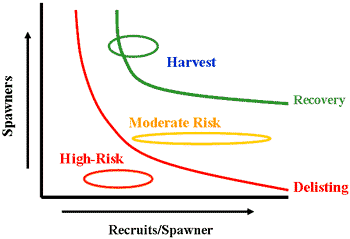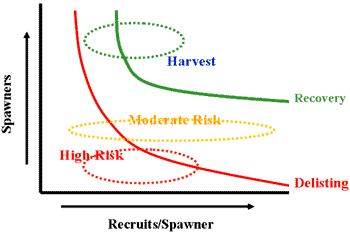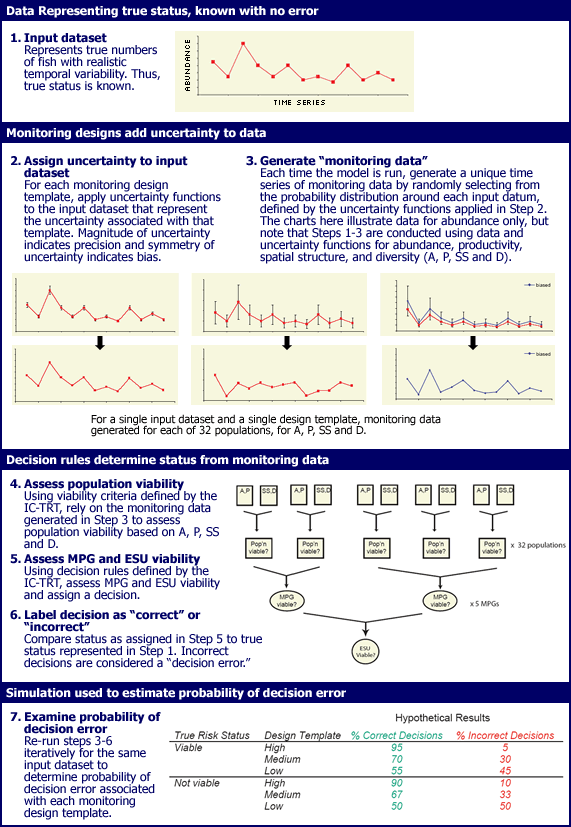Status and Trends Monitoring and Evaluation Designs
Salmon, steelhead, and bull trout occupying the Snake River Basin have declined precipitously to abundances warranting protection under the Endangered Species Act (ESA). CSMEP's Status and Trends Workgroup has focused its initial efforts on identifying monitoring design elements necessary to address one of the most important management decisions in the Snake Basin for one key species:
Has there been sufficient improvement in the status of Snake River Sp/Su Chinook to justify delisting the ESU and allow removal of ESA restrictions?
This decision is based on the abundance, productivity, spatial structure and diversity of Snake River spring/summer (SRSS) chinook over the prior 10 years (IC-TRT 2005).
The Status & Trends Workgroup is developing a simulation model that can be used for evaluating alternative designs for monitoring the status and trends of SRSS chinook at the population, major population group and ESU scales. Monitoring designs are described as high, medium, and low templates, in reference to the levels of accuracy and precision in data that are collected using each template (see map-based illustration of potential designs). Alternative design templates will be compared in terms of cost and probability of error in decisions that are associated with individual templates. The immediate objective of the simulation model is to evaluate the ability of alternative designs to reliably determine the status of SRSS chinook. The ultimate objective is to develop a tool that can be adapted for developing monitoring designs in other subbasins and for other fish species as required.
Assessing the Ability of Monitoring Designs to Reliably Determine Status of Snake River Sp/Summer Chinook Salmon
CSMEP's simulation model is intended to allow exploration of the four data elements required for informing TRT decisions on species delisting: abundance, productivity, spatial structure, and diversity.
The model will be applied to assess the reliability of decisions for up to 31 populations and 5 Major Population Groups in the Snake River ESU based upon a range of potential sampling designs and monitoring protocols. Sensitivity analysis will be used to examine how the rate and direction (type I versus type II) of decision error responds to uncertainty in monitoring data.
Status & Trend Decision Rule - Abundance & Productivity
To delist: need less than 5% risk of declining to less than a critical number of spawners in 100 years.
|
Example: |
 |
|
Assuming 20% |
 |
To determine how specific monitoring protocols influence uncertainty in data, monitoring data must be compared to a performance standard (usually a census dataset) using calibration studies. Calibration studies can provide information on the accuracy and precision achieved by varying: 1) the location and temporal pattern of measurements ("sampling design"); 2) the specific types of measurements that are to be made ("response design"); and 3) the analyses to be performed to make a decision ("evaluation design"). Sensitivity analyses will identify where uncertainty in monitoring data most strongly affects error in final decisions; thus, sensitivity analyses can suggest monitoring activities for which calibration studies are justified.
Schematic of Status and Trends simulation model for evaluating alternate monitoring designs

Mapping of current and alternative CSMEP monitoring designs




Final Work Product Documents Associated with Status and Trends Monitoring and Evaluation Designs
Technical Status and Trends Reports/Links
| NOAA-NMFS: Integrated Status and Effectiveness Monitoring Program |
| NOAA-NMFS: Northwest Salmon Recovery Planning |